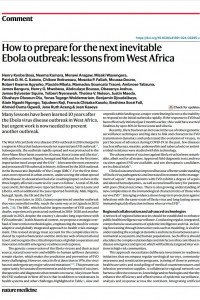Henry Kyobe Bosa, Neema Kamara, Merawi Aragaw, Misaki Wayengera, Patrick D. M. C. Katoto, Chikwe Ihekweazu, Mosoka P. Fallah, Moussa Douno, Robert Kwame Agyarko, Placide Mbala, Mamadou Souncalo Traoré, Ambrose Talisuna, James Bangura, Henry G. Mwebesa, Abdoulaye Bousso, Obasanya Joshua, James Sylvester Squire, Tolbert Nyenswah, Thelma V. Nelson, Justin Maeda, Olushayo Oluseun Olu, Yonas Tegegn Woldemariam, Benjamin Djoudalbaye, Alain Ngashi Ngongo, Tajudeen Raji, Francis Chisaka Kasolo, Ibrahima Socé Fall, Ahmed Ouma Ogwell, Jane Ruth Aceng & Jean Kaseya
Many lessons have been learned 10 years after the Ebola virus disease outbreak in West Africa, but urgent work is now needed to prevent another outbreak.
The West African Ebola virus disease (EVD) outbreak in 2014 emerged in a region in Africa that had previously not reported any EVD outbreak. Subsequently, the outbreak rapidly spread and was protracted in the three Mano River basin countries (Guinea, Sierra Leone and Liberia), with spillover cases in Nigeria, Senegal and Mali and, for the first time, importation into Europe and the USA. It became the most extensive and protracted EVD outbreak in history, followed by the 2018 outbreak in the Democratic Republic of the Congo (DRC). For the first time, cases were reported in urban centers, underscoring the urban spread of the disease. Its devastation had a far-reaching impact on lives in the three largely affected countries for years to follow. A total of 28,616 cases and 11,310 deaths were reported from Guinea, Sierra Leone and Liberia, with an additional 36 cases reported from Italy, Mali, Nigeria, Senegal, Spain, the UK and the USA.
Five years later, in 2021, Guinea experienced another outbreak that was controlled swiftly, much the same way as in Uganda in 2022. The DRC, which had the largest number of EVD cases and deaths, experienced a protracted outbreak in 2018–2020 and another episode in 2021, despite the country’s decades-long experience with EVD outbreaks. In this historical context, we propose a strategic overhaul of intervention methodologies, emphasizing the need for a more adaptive and globally integrated approach to health crisis management. This revised strategy must account for the complexities introduced by rapid urbanization and the intricate web of international travel, and recognize the critical importance of global cooperation and innovation in health emergency readiness and response.
The genetic conservation of the Ebola viruses and their actual source, natural reservoirs and wildlife-to-human spillover dynamics remain elusive, which makes the prediction and prevention of EVD more challenging. However, since its first detection in 1976, the virus has not undergone any major selected mutations. This presents an opportunity for sustained investment in and development of vaccines, therapeutics and diagnostics that remains on course. A key lesson from the EVD outbreak in West Africa is that in addition to weaknesses in health systems and other challenges highlighted in Table 1, slow and unpredictable funding was a major contributing factor to the inability to respond to the initial outbreaks rapidly. If the response to EVD had been effectively initiated just 2 months earlier, this could have averted fatalities by up to 80% in Sierra Leone and Liberia.
